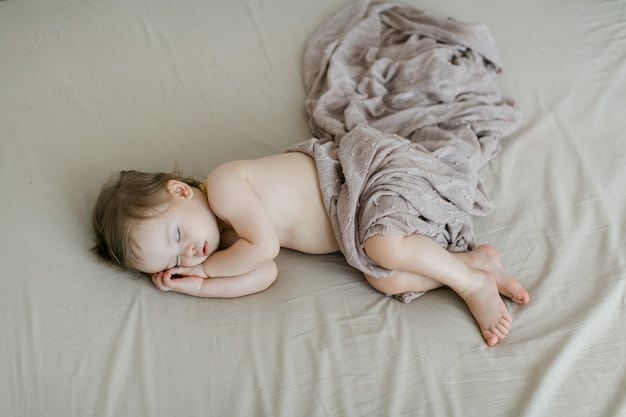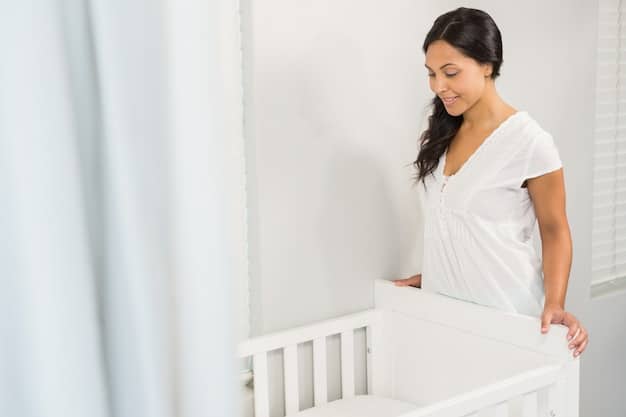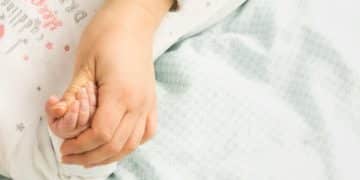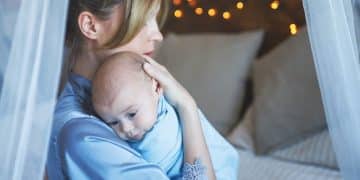Preventing SIDS: Updated Safe Sleep Guidelines for 2025

Updated safe sleep guidelines for 2025 emphasize placing babies on their backs to sleep on a firm surface, in a crib free of soft objects, to significantly reduce the risk of Sudden Infant Death Syndrome (SIDS).
Ensuring your baby’s safety during sleep is paramount. Preventing SIDS: Updated Safe Sleep Guidelines for 2025 provide crucial recommendations to minimize risks and promote a secure sleep environment for your little one.
Understanding SIDS: What Parents Need to Know
Sudden Infant Death Syndrome (SIDS) is the unexplained death of an infant under one year old, usually during sleep. Understanding SIDS and its risk factors is the first step in protecting your baby.
What is SIDS?
SIDS is often referred to as “crib death” because the infant is usually found dead in their crib. While the exact cause remains unknown, research has identified several factors that can increase the risk.
Risk Factors for SIDS
Certain factors can elevate a baby’s risk of SIDS. Being aware of these can help parents take preventive measures.
- Premature birth or low birth weight.
- Exposure to cigarette smoke during pregnancy or after birth.
- Overheating during sleep.
- Sleeping on the stomach or side.
By staying informed about these risks, parents can implement strategies to mitigate them, creating a safer sleep environment for their baby.

Ultimately, the goal is to reduce preventable risks, empowering parents with the knowledge to make safe sleep choices.
Key Updates in the 2025 Safe Sleep Guidelines
The safe sleep guidelines are continually updated based on the latest research. The guidelines for 2025 include specific recommendations for creating a safe sleep environment.
Back to Sleep
Always place your baby on their back to sleep. This is the most important step you can take to reduce the risk of SIDS.
Firm Sleep Surface
Use a firm sleep surface, such as a crib mattress that meets safety standards. Avoid soft mattresses or surfaces like sofas or armchairs.
Bare Crib
Keep the crib bare. This means no pillows, blankets, bumper pads, or toys. These items can pose a suffocation risk.
These guidelines are designed to provide the safest possible sleep environment for your baby, minimizing the risk of SIDS and promoting overall well-being.
Creating a Safe Sleep Environment: Step-by-Step
Creating a safe sleep environment involves several key steps. By following these guidelines, you can significantly reduce the risk of SIDS.
Choosing the Right Crib
Select a crib that meets current safety standards. Ensure all screws and bolts are tightened, and that the mattress fits snugly.
Using a Fitted Sheet Only
Cover the mattress with a fitted sheet only. Avoid using loose blankets or sheets, as these can pose a suffocation risk.
Room Sharing, Not Bed Sharing
The American Academy of Pediatrics recommends room-sharing without bed-sharing. Keep the baby’s crib or bassinet in your room for at least the first six months.

These steps are practical and can be easily incorporated into your baby’s sleep routine, ensuring a safer environment.
Debunking Common Myths About Safe Sleep
Several myths surround safe sleep practices. Understanding the facts versus fiction can help you make informed decisions for your baby.
Myth: Babies Sleep Better on Their Stomach
Fact: Placing babies on their stomach significantly increases the risk of SIDS. Always put your baby on their back to sleep.
Myth: Bumper Pads Protect Babies
Fact: Bumper pads pose a suffocation risk and offer no protective benefit. The American Academy of Pediatrics recommends against using them.
Myth: It’s Okay to Use a Soft Blanket in the Crib
Fact: Soft blankets, pillows, and toys can pose a suffocation risk. Keep the crib bare, using only a fitted sheet.
By understanding and avoiding these myths, you can ensure that you are following evidence-based safe sleep practices.
The Role of Healthcare Providers in Preventing SIDS
Healthcare providers play a crucial role in educating parents about safe sleep practices. Regular check-ups can help ensure that parents are following these guidelines.
Prenatal Education
Healthcare providers should begin educating expectant parents about safe sleep practices during prenatal visits.
Postnatal Guidance
After the baby is born, healthcare providers should reinforce safe sleep guidelines at each check-up, answering any questions parents may have.
- Discuss the importance of back sleeping.
- Explain the risks of bed-sharing.
- Provide guidance on creating a safe sleep environment.
The partnership between parents and healthcare providers is essential for promoting safe sleep practices and reducing the risk of SIDS.
Additional Tips for Safe Sleep: Beyond the Basics
Beyond the basic guidelines, several additional tips can further enhance your baby’s sleep safety.
Avoid Overheating
Dress your baby in light clothing and keep the room at a comfortable temperature. Avoid overdressing, which can lead to overheating.
Consider a Pacifier
Offering a pacifier at naptime and bedtime may reduce the risk of SIDS. If the pacifier falls out after the baby is asleep, don’t put it back in.
Ensure a Smoke-Free Environment
Exposure to cigarette smoke increases the risk of SIDS. Ensure that your baby is not exposed to smoke during pregnancy or after birth.
By following these additional tips, you can create an even safer sleep environment for your baby, promoting their health and well-being.
| Key Point | Brief Description |
|---|---|
| 🚼 Back to Sleep | Always place your baby on their back to sleep. |
| 🛏️ Firm Surface | Use a firm mattress in a safety-approved crib. |
| 🧸 Bare Crib | Keep the crib free of soft objects like pillows and toys. |
| 🚭 Smoke-Free | Avoid exposing your baby to cigarette smoke. |
Frequently Asked Questions (FAQ)
▼
The safest sleep position is on the back. This reduces the risk of SIDS significantly. Always place your baby on their back for naps and nighttime sleep.
▼
Car seats are not recommended for regular sleep. If your baby falls asleep in a car seat, move them to a firm, flat surface as soon as possible to reduce risk.
▼
The American Academy of Pediatrics recommends that babies sleep in the same room as their parents, but not in the same bed, for at least the first six months.
▼
Avoid placing pillows, blankets, bumper pads, and toys in the crib. These items can increase the risk of suffocation. A fitted sheet on a firm mattress is all that is needed.
▼
Some studies suggest that using a fan in the baby’s room may help reduce the risk of SIDS. It promotes air circulation and helps maintain a comfortable temperature.
Conclusion
By adhering to the updated safe sleep guidelines for 2025, parents can create a secure environment that promotes the well-being of their infants and significantly reduces the risk of SIDS. Staying informed, implementing practical measures, and consulting with healthcare providers are key to ensuring the safest sleep possible for your baby.





